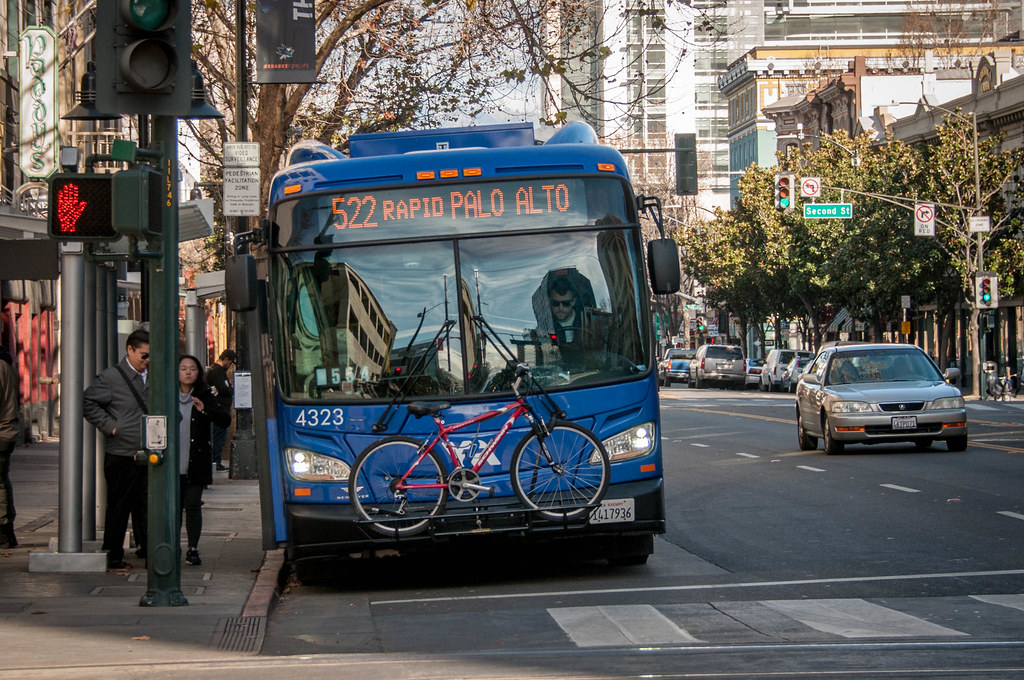We have great news for the future of transit in San José! On August 9, the San José City Council adopted a resolution approving a new City Council Policy “Transit First Policy,” alongside its parent plan, Move San José. The new policy will prioritize transit operations and passenger access in plans and operational decision-making.
The Transit First Policy will guide City staff in decisions about how to design streets and sidewalks. When we get to a point where we need to think about tradeoffs – how to use extra road width, for example – this policy directs us to put transit riders’ best interests first. This means a better experience for transit riders and increased transit ridership. This approach will help the City reach our climate and equity goals.
Isn’t transit VTA’s responsibility?
Our partners at Valley Transportation Authority (VTA), Bay Area Rapid Transit (BART), and Caltrain run most of the transit service that carries people to, from, and through San José.
But the City controls a lot of the infrastructure and built environment that transit uses. That means our decisions and investments influence how quickly, comfortably, and safely people can get around using buses and light rail. Similarly, our local infrastructure can make it easier and more pleasant to get to Caltrain stations. City street design impacts the convenience, safety, and comfort of people walking, scooting, or bicycling to and from transit stops. And we are deeply invested in the future expansion of BART.
Why create this policy now?
The Transit First Policy is needed now. Transit service is getting slower right when we need it more than ever. Transit helps us fight climate change and improve access to opportunities for communities that have been underserved by government.
Transit service in San José has gotten slower over the years because of traffic congestion and decisions by the City that have prioritized automobiles over other modes of transportation. This slower service makes riding transit less attractive to potential riders and more expensive to operate. It also encourages more people to drive, further adding to congestion, traffic, and more dangerous streets for people who walk or bike.
What does the policy actually do? Will we start seeing more buses on the street?
The policy will impact choices that get made in operations, design, and planning projects. Opportunities to favor transit come up during our annual pavement program street redesigns, through grant-funded safety improvements, or as part of signal retiming projects. When we have to make choices about how to use our limited road space, this policy directs us to favor transit.
The Transit First Policy will apply to two kinds of streets:
- Grand Boulevards (which are designated as primary transit corridors in our general plan)
- Other streets where frequent transit goes.
Throughout San José, parts of VTA’s High Quality Transit Network (routes that pick up passengers every 15 minutes or less) operate on streets that are not called out as Grand Boulevards in the general plan.
The new policy directs city staff to evaluate and recommend applying the same design and transit priority principles that are intended for Grand Boulevards to those other streets when we can. It tells planners and engineers to invest in transit priority features on those streets, just like on Grand Boulevards. Ultimately, that will help buses keep up their pace and serve riders better when they turn off a Grand Boulevard onto a smaller street.
As we improve the transit environment on streets throughout the city, there may be tradeoffs that impact drivers. But the improved speeds and reliability are intended to attract more people to transit, which will in turn get cars off the road. And fewer cars on the road means better health, improved safety, and less stressful travel for everybody.
